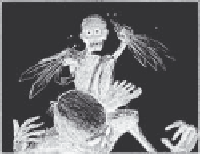Graphics Reference
In-Depth Information
are easy to read in any culture as they are common sense, but most countries have developed
gestures totally incomprehensible to others. These develop much like dialects and as a result
of specii c cultural references and backgrounds. An outsider would be hard pushed to make
sense of Japanese Kabuki theatre, where every movement has a meaning specii c to that art
form. The audience has learnt exactly what a l ick of the head means, or understands the colour
coding of a piece of fabric, but these clues are not connected to the same logic that makes
hands l uttering over a heart easy to understand. When dealing with any body language you
have to think whether it is a learned gesture, a natural gesture or a cultural gesture. When
I learnt British Sign Language for
Screen Play
, I was surprised that this was not a universal
language and that some signs had clearly dif erent meanings elsewhere. A two-i ngered salute
can have far too many meanings. For stop motion, it's all about i nding the appropriate, truthful
and honest vocabulary.
Whenever you have a scene with several characters, or even just two, you need to ask yourself
just who is the focus. Which character is the active one; who is looking at who; or rather, who
should the audience be looking at. There are so many ways to focus attention on the main
character, which is probably just another way of saying 'make sure the story comes across clearly.
You do not want the audience to be distracted by unnecessary stuf going on in the background.
During a scene the power and focus will probably shift back and forth between characters, and
the relationship will change. There are plenty of body language tricks to show who is in control.
Try and study how characters echo each other, or move in synchrony, or assume opposite poses,
or slouch or stand tall, or turn away or invade the other's body space. There are plenty of great
topics about body language, but you do need to be familiar with how characters respond to
each other. Again, watch animals together, as they seem unable to hide their reactions to each
other as we can. The bodies communicate more clearly. It is unlikely that two characters will just
stand still in each other's presence without giving something away, unless that stillness is part of
some larger expression. It's not just unlikely, it's also very uninteresting, and that is one thing we
just cannot af ord to be. For every scene with characters communicating, just ask yourself how
you can use the physicality to make the scene more interesting
Finding the body language
Before even thinking about i lming you need to think how the characters are going to move.
One of the i rst commercials I animated and directed was a campaign to introduce a soft chewy
cereal bar alongside a crunchier chunky bar. The ad showed two humanesque i gures made out
of the respective cereals, beautifully sculpted in amazing detail. It was inevitable that the female
character would be the soft one, and the male the crunchy one. The curves on the female
were emphasised and the male i gure actually had sharp edges, giving him a feeling of being
a slab of oats. These two i gures undressed sexily from their wrappers, then performed a very
athletic ballet. They got a bit carried away, then realised they had an audience, and slunk back
into their wrappers. An original idea was for the male to get a bit too intimate with
the female, and she was to knee him gently in the groin, at which point two 'nuts'
would have fallen of . For some reason this never made it into the i nal shoot, but
the male's punishment for getting too frisky was to get himself caught as he pulled
his wrapper up round him, as if catching himself in his l y. Gloriously bizarre. The
challenge for me was to show the dif erence in the bars by the way they moved,
and we managed. The agency producer and I danced around a vacant oi ce trying


Search WWH ::

Custom Search